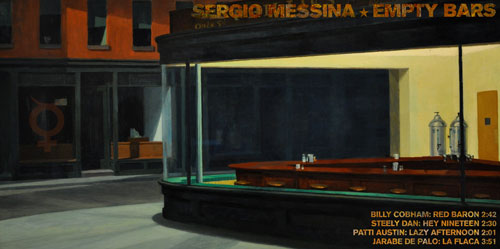The other night I couldn't sleep so I made an album. It's one of those tiny ideas that make themselves, all the pieces simply falling into place. I had been thinking about it for a while, then I made it. It's called Empty Bars, and until now is about 10 minutes long. Here's the story:
Since a long time, I've been interested in working with sound in the same way you work with wood or stone: carving it. I've employed many means to carve sounds, from the obvious (graphic equalizers) to the very unorthodox (using Skype as an echo machine). Of course when we think of carving we always refer to a 3 dimensional activity. But music's canvas (or marble) being time, you can think of editing as a form of carving too, of removal, especially if you edit a known piece of music (or sound design). If you chop up and reassemble The Rite of Spring, you could say you're reshaping it (another visual metaphor).
One of my most accomplished radio pieces (in my opinion) is Ituri Good Time, made for Radiotopia , a Kunstradio project, in 2002. I took a long field recording of the african Ituri people walking in the jungle (with many songs), and removed the songs - leaving only the background, chatter, laugh, incidental sounds, etc.
Since many years I've been fascinated by empty bars in songs, those (rare but not too uncommon) sections of pop songs where nothing (or almost nothing) happens. I'm not talking about dance music, where empty bars are the norm. I'm talking about music played by humans where there are bars intentionally left blank. Of course there's a culture of these empty bars, the Breakbeat culture (and Simon Harris was one of its prophets; his BB albums were incredible to listen to, al least for me: a kind of funky Philip Glass), but the idea was slightly different: to find one or two empty bars and loop them for a few minutes, for DJs and producers. My approach is more philological: I simply take a song that has many empty bars and edit out the "song". Disclosure: the perfect band for this exercise is Steely Dan. I picked out Hey Nineteen because it's perhaps the single song with more blanks I know (amazingly enjoyable, because of the sublime skills of the players and the beauty of the beat itself). Of course none of these bars are actual "repetitions" in a digital sense of the word, and neither they're truly empty. But my impression is that they were included for a reason that I've been reflecting upon for quite a while now (and my students know very well).
Of the many amazing similarities between architecture and music, the ability of sound to define a space is one of the most obvious. This is especially true with loop-based music (you may say repetitive, it's the same). The repetition creates a static place where our body exists, for the duration of the repetition (if we like the experience we might repeat the repetition , often many times). This sonic place can be comfortable or scary, pleasant or nightmarish, can make you feel cool or suicidal. Most loops are devised to please, of course, and such is the case for the songs I've picked for Empty Bars. I believe they played those extra bars to give us (and themselves) the pleasure to linger in those places for longer, being very pleasant spaces.
Of course the illustration happened easily as well: take the most famous bar in the History of Art (Nighthawks by Edward Hopper) and empty it.
All tracks are here for demonstrational purposes only, and only in parts. If you don't know them, you should buy these tracks (following the links of the album names): you'll have much more fun listening to EB if you know the original versions.
Red Baron 2'38
Billy Cobham, from the album Spectrum (1972)
Hey Nineteen 2'30"
Steely Dan, from the album Gaucho (1980)
Lazy Afternoon 2'02"
Patti Austin, from the album The Real Me - (1988)
La Flaca (Uno Fuera version) 3'51"
Jarabe the Palo, from the album La Flaca (1998)
(this one was made in 2005 and it's not exactly just edits. But it's still a song without the song - just a little demented extra that I extended to death)
© by the original authors - quoted here in parts for educational purposes only.
